

Attribution:
This page is entirely compiled from books about clothing and jewelry, with commentary either by the authors, or by people who have sent me scans of their material, as noted.
Goal:
It is intended as a seductive resource for folks interested in this time period to track down the few whole-garment examples we have. (Look! See how keen these are?) In some cases, the museums currently holding these pieces will have websites, published books or archeological findings, collection catalogs, libraries of images that they will duplicate for you (usually you have to be onsite to use the libraries) and so forth.
Format:
I plan to only have photos and descriptions of complete garments here, and ones generally earlier than 1500. For cut and patterning of these garments, an excellent place to start is with Marc Carlson's pages on extant garments. There are many more fragments which are less astonishing than these, and although not as flashy, very useful information can be gained by studying them. A good place to start on those is the Museum of London series; see the listings in my Further Reading page.
Some of these garments are from church or synagogues, and while you may not want to recreate a cope, the fabrics are similar to or identical to those in use by the nobility at that time. Use them as guides for buying fabric!
Keep in mind that interpretations may change as new material is
discovered
or conserved. Happy Hunting!
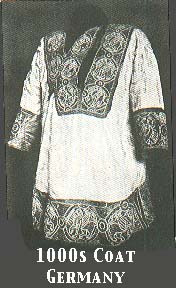 |
11th century coat of Henry II, German From Kohler, which gives no color information nor museum info. |
 |
Hungarian coronation mantle detail, c.1031 Ars Hungarica (Hungarian National Museum) <--click for larger detail of half-circle mantle For this, and all the other Hungarian examples, I am indebted to Kolozsvari Arpad for the loan of his books. |
 |
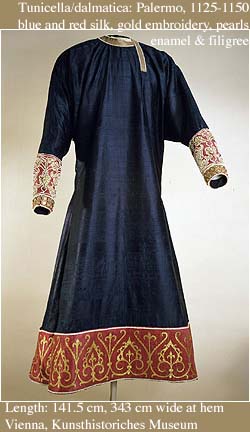 1130
or later Dalmatic sleeves, Kunsthistorische Museum, Vienna 1130
or later Dalmatic sleeves, Kunsthistorische Museum, Vienna
Palermo, Royal workshop, between 1130 and 1154 See a drawing of the whole garment. Contributed by Dietmar. |
 |
1133, Coronation mantle of the Holy Roman Emperor,
Kunsthistorische
Museum, Vienna Red silk, embroidered in gold; gold filigree, enamel, precious stones, and pearls, showing a lion's battle with a camel. W 342cm The Cufic inscription in Arabic round the hem states that the robe was made in 1133/4 by Arab artists for King Roger II of Sicily. It came into the possession of the Emperor Friedrich II with the Sicilian inheritance. It is thought that he incorporated the robe into the Imperial treasure after his coronation in Rome in 1220. contributed by Dietmar See more photos at http://www.khm.at/nobiles/en/02/objects.html |
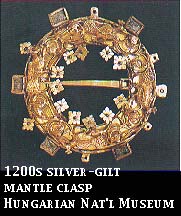 |
1200s silver-gilt mantle clasp, peacock design Hungarian National Museum Guide |
 |
1200s silver-gilt crown, St. Margaret (of Hungary?) "in the
french
style" Hungarian National Museum Guide |
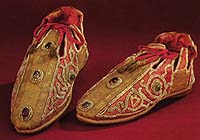 |
1220, Shoes of the Holy Roman Emperor. Kunsthistorische
Museum,
Vienna Sicily, beginning of the 13th century, altered in Nu"rnberg between 1612 and 1619 Calf with red silk and gold edging; precious stones and pearls; L 25.5 cm and 26 cm each . Like the gloves, these shoes were presumably made before 1220 for the Emperor Friedrich II. contributed by Dietmar |
 |
1220, Gloves of the Holy Roman Emperor. Kunsthistorische
Museum, Vienna
Sicily, beginning of the 13th century contributed by Dietmar |
 |
1244 sideless surcoat of "arabian brocade" belonging to
Leonara
of Aragon. In the possession of the Monastery of Las Huelgas,
near
Burgos.
From Boucher. Color details, from a book from Spain (I hope to have a color scan eventually.) The overall color is medium blue with white patterns, and some horizontal medium green stripes. |
 |
1250s Chasuble of St. Bernard in the Aachen Cathedral
Treasury Rhine-Meuse region 2nd half of the 12th century. Pearl ornaments - Romanesque border on the collar. The dark blue silk fabric is from Baroque times. Bernard of Clairvaux is said to have worn this chasuble at Aachen in the year 1147, when he called the people to a crusade. Contributed by Dietmar. |
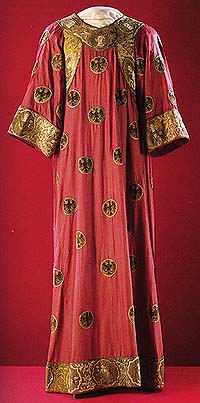 |
Eagle Dalmatic, South German, 1st half of 14th c. Chinese purple damask, c. 1300; gold and silk embroidery This is an excellent example of what "Royal Purple" really is -- a rather reddish purple. Grape purple is not the same color at all! Closeup of collar and sleeve. Many thanks to Dietmar, who sent me this scan and info. |
 |
A "Sakkos"from the 1300s. Image from the Metropolitan Museum's Byzantine exhibit http://www.metmuseum.org/special/Byzantium/gallery_5.asp -- do visit the website for close ups and views of the back, as well as extensive details about construction and who would have worn it. |
 |
1300s surplice, French. National Museum, Munich.
Note band of trim across chest, shoulders, and vertical in
center.
Godets at side reinforced (?) with embroidered patches that match
cuffs. additional info from Nancy Stengel |
 |
1300-1320 Syon cope at the V & A Museum 4'8"w x 9'7"l (1.5m x 3m) This picture is Very Poor color registration; click here for a natural-light picture by me. Thought to be made near Coventry, based on the heraldic artwork. Embroidery "opus Anglicanum" is worked in colored silk and gold and silver thread on linen ground. contributed by Dietmar |
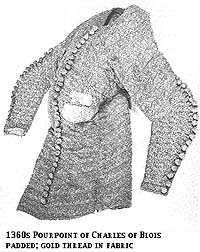 |
1360-ish Pourpoint of Charles of Blois. Lyon,
Musee Historique
des Tissues Fashion in the Age of the Black Prince (source of the photo to the left) states: In what is in effect a padded doublet, its outer layer of splendid silk patterned with gold, the padding has been so disposed that it enlarges the chest, and, by the closeness of its fit to below the hips, it must have maintained a corset-like grip round the body below the waist. Its sleeves are set onto the body part in the manner known as the grande assiette.A contrasting opinion, from Paul Lalonde, on the H-costume list: Now, I, like many other 14th century geeks, have memorized the photos, not to say the cut of the thing, but have been unable to adequately explain the way it looks quilted.A visitor to my web pages was interested in this aspect, and wrote to the museum to ask if the quilting was as a result of conservation; they wrote back: "I had confirmation from the person who did the conservation that the pourpoint was originally quilted with cotton. Very cordially, Vincent Cros, Bibliothèque Centre de Documentation, Musée des tissus et Musée des Arts décoratifs de Lyon" Here's a closeup of the fabric. |
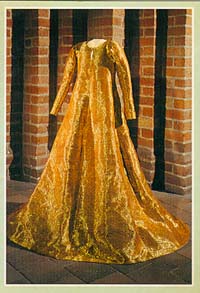 |
RECONSTRUCTION: The Uppsala Gown or The Golden Gown of Queen
Margaret,
appx 1400. (b.1353 -- d. 1412) Picture sent to me by Bjarne Drews There's contradictory stories for how old Margaret was when she wore this gown; some put it at 1363 or so, when she was 10, but apparently radio-carbon dating puts it in the range of 1403-39, when she was 50 to 59! Others say it may be a generation later, and not Margaret's. I have moved the additional information about this gown to a new page. See the page for commentary and examples of the reconstructed brocade pattern. See also Marc Carlson's page about this gown. I think this gown would not be this stiff after a few wearings. |
 |
ORIGINAL: The Uppsala Gown or The Golden Gown of Queen
Margaret, appx
1400.
Thanks to the Historic Costume folks, who have pointed out that the alleged pattern digram in the book attributed to Carl Kohler and written in the 1870s, edited and republished in 1928 with a 1911 pattern of the gown, was disproved in 1985 by modern conservators. (A good example of why you must take Victorian costume books with a lot of salt.) The picture at left is the b&w photo from Kohler.
Marc listed
the best reference for this gown, which is: Geijer, Agnes, Anne Marie
Franzen
and Margareta Nockert. Drottning Margaretas gyllene kjortel i
Uppsala
domkyrka. Stockholm: Kingl. Vitterhets Historie och
Antikvitets
Akademien, 1994. [The Golden Gown of Queen Margareta in Uppsala
Cathedral]
Note that this is the more desirable later edition (first was in 1985).
|
 |
Fifteenth century purses; cut velvet; leather, with iron
clasps.
New York Metropolitan Museum. From Boucher |
 |
1400s jewel; gold with white enamel. The swan is held
captive
by a crown-shaped collar. British Museum Souvenir Guide |
 |
1414 Coronation robe (Cappa Leonis) Aachen Cathedral
Treasury contributed by Dietmar Made in the 14th century or for the coronation of Sigismund in 1414. Named after the legendary consecrator of the Aachen cathedral, pope Leo III, the robe was probably worn during the coronation of Sigismund in 1414. The reddish-brown velvet is covered with small white blossoms
in squares
which are framed by knit golden threads. The front part of the hem
shows
an embroidered border with quatrefoil alternately adorned with three
dimensional
little birds and heraldic shields. Along the lower hem of the robe
there
is a broad, embroidered border with flowers, stars, and the figures of
prophets, together with a band carrying 100 hammerless silver bells
which
produce sounds by knocking each other. |
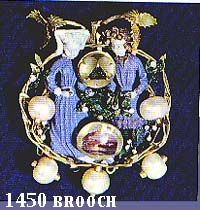 |
Netherlandish brooch from 1450; enamel, gold, stones,
pearls.
Vienna, Kunsthisoriches Museum.
From Boucher |
 |
Red satin jacket of Charles the Bold, 1477. View from
the back;
front has buttons from neck to waist. Berne, Historical Museum.
From Boucher |
 |
The Guide to the Historical Exhibition of the Hungarian
National
Museum (11th-17th centuries) reports:
The attire of Queen Mary and Louis II came in the possession of the Hungarian National Museum in 1928, from Mariazell, a place of pilgrimage. The gown of the queen was made of Italian silk damask after the Burgundian fashion between 1520 and 1530.Mary is also referred to as Archduchess of Austria, Queen of Hungary and Bohemia, Regent of the Netherlands (Mary of Hungary, by Jane deLongh, 1858) She was the grand-daughter of Mary of Burgundy. See the cutting diagram & measurement article. These scans are nearly identical colors to the Guide; moss green gown with light russet accents. Here are closeups: Bodice - Skirt - Cuff. Don't forget to click on the picture to the left for a larger view. The belt looks as if it's made of two semi-circular sections, possibly hinged at the back. News Flash! Friends have been to the museum recently and report that the russet fabric and the green are damasks with metallic gold. |
There are a larger number of clothing fragments than there are whole garments, but as this page is intended to inspire the casual visitor, I've not gone into those here. I plan to shortly web a bunch of photos and drawings of fabric scraps.
If these interested you, you may be interested in my account of
seeing
1400s
fabric in person.
| © 2000 Cynthia Virtue except as noted | Email Author with comments |
| Back to Virtue Ventures Main Page | Back to Article Index |